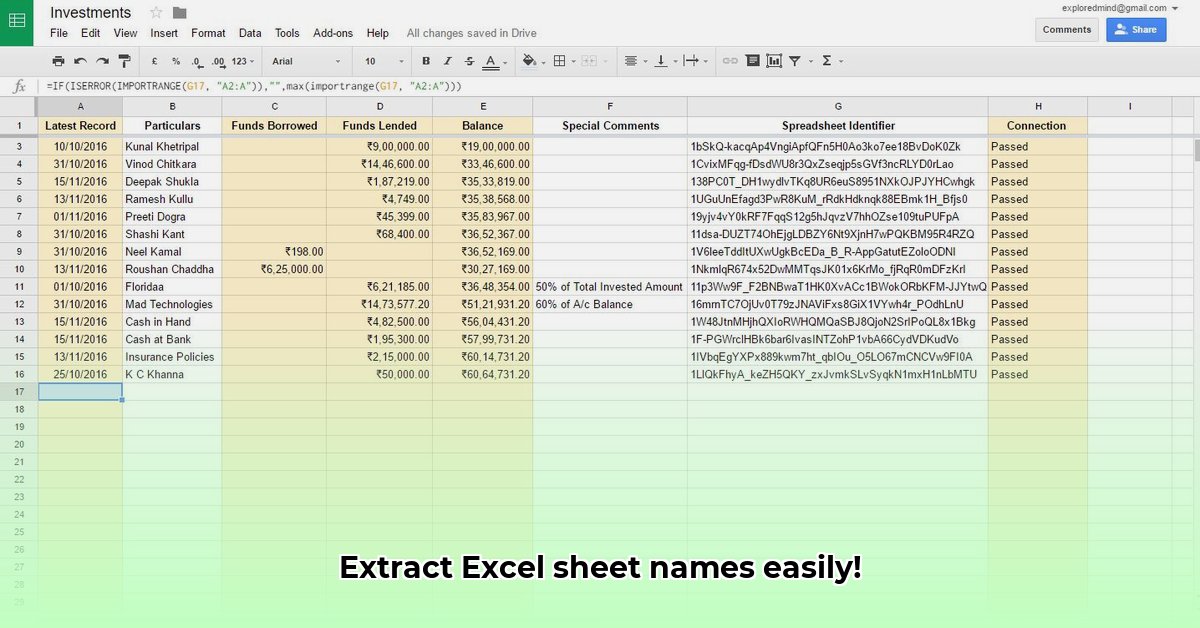
Need to extract the name of an Excel worksheet? This guide provides several methods using Excel formulas, comparing their strengths and weaknesses to help you choose the best approach for your situation.
Method 1: Combining CELL, RIGHT, LEN, and FIND – A Simple Approach
This method uses four functions together to extract the worksheet name from the full file path returned by CELL("filename"). While straightforward, it's less reliable with unusually formatted file paths.
Steps:
Get the Full File Path: Use the
CELL("filename")function (returns the complete file path, e.g., "C:\Documents\MySpreadsheet.xlsx").Locate the Last Slash: Use
FIND("/",CELL("filename"))to find the position of the last forward slash (/), separating the folder path from the filename.Get the Total Path Length: Use
LEN(CELL("filename"))to get the total number of characters in the file path.Extract the Worksheet Name: Use
RIGHT(CELL("filename"),LEN(CELL("filename"))-FIND("/",CELL("filename")))to extract the characters after the last slash. This is your worksheet name.
Example: For the file path "C:\Users\Documents\MyExcelFile.xlsx", FIND locates the last "/", LEN returns 37, and RIGHT extracts the last 18 characters ("MyExcelFile.xlsx"). Note that this only gives the filename, not the sheet name itself. This method requires further refinement to isolate the sheet name within brackets if it exists like this [Sheet1]MyExcelFile.xlsx.
Pros: Easy to understand for beginners. Works well for many standard file paths.
Cons: Unreliable with unusual file paths. Struggles with long filenames or unusual characters. Lacks error handling. Doesn't directly extract sheet name from file paths containing it within brackets [SheetName].
Method 2: Using MID – More Control and Reliability
The MID function provides more control, making it more robust than Method 1.
Steps:
Get the Complete File Path: Use
CELL("filename").Find the Last Slash: Use
FIND("/",CELL("filename"))to find the position of the last slash.Determine Starting Point: Add 1 to the last slash position; this is where the file name begins.
Determine the Length: Subtract the last slash position from the total path length (
LEN(CELL("filename"))). This is your file name length. Consider capping this length (e.g., to 255) to prevent unintended extractions.Extract the Filename: Use
MID(CELL("filename"),FIND("/",CELL("filename"))+1,255)to extract up to 255 characters starting after the last slash. This still requires refining to get the sheet name (within brackets).
Pros: More reliable than Method 1; handles longer path names better. Better at handling unusual characters.
Cons: More complex than Method 1. Relies on standard file path formatting. The length cap (255 in the example) might need adjustment for extremely long file names. Lacks error handling. Still doesn't directly extract sheet name within brackets from the file path.
Method 3: TEXTAFTER – The Elegant Solution (Excel 2019 and Later)
For Excel 2019 and later, TEXTAFTER simplifies the process. However, it needs refinement to extract the sheet name within brackets accurately.
The formula =TEXTAFTER(CELL("filename"),"/",-1) extracts text after the last forward slash. This still won't directly address sheet names in brackets.
Pros: Clean and easy to read. Very reliable for its intended purpose.
Cons: Only works in Excel 2019 and later. Doesn't directly extract sheet name from the file path when it's enclosed in brackets.
Addressing the Bracketed Sheet Name: A Refinement
All previous methods require additional steps to correctly extract the sheet name if it's enclosed within brackets as [SheetName]MyExcelFile.xlsx. We need to incorporate MID, FIND, LEFT, and RIGHT functions. This is to extract the string between the opening and closing brackets. This example assumes the sheet name is always within brackets and directly follows the last slash and precedes the actual filename.
Adapting Method 2, a more sophisticated formula would look like this (assuming your file path is in cell A1):
=MID(A1,FIND("[",A1)+1,FIND("]",A1)-FIND("[",A1)-1)
This formula finds the "[" bracket and extracts characters until the "]" bracket, effectively isolating the sheet name.
Choosing the Right Method
The best method depends on your Excel version and needs:
- Older Excel versions & simple needs: Method 1 is relatively easy to understand, but lacks robustness.
- Older Excel versions & complex needs: Method 2 offers a better balance of ease and reliability.
- Excel 2019 or later: Method 3 using
TEXTAFTER, coupled with the bracket extraction method given above, is the most efficient and straightforward for extracting sheet names from formatted file paths. Always test thoroughly and add error handling.
Handling Errors: The IFERROR Function
To prevent errors, use IFERROR:
=IFERROR(MID(A1,FIND("[",A1)+1,FIND("]",A1)-FIND("[",A1)-1),"Sheet name not found")
This returns the sheet name or a user-defined message if an error occurs.
Remember to always thoroughly test your formula. For complex scenarios or automation, consider VBA macros for a more robust solution.